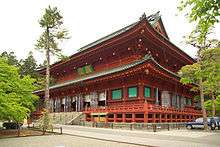Rinnō-ji
Rinnō-ji (輪王寺) is a Tendai Buddhist temple buildings in the city of Nikkō, Tochigi Prefecture, Japan.
| Rinnō-ji | |
|---|---|
 | |
| Religion | |
| Affiliation | Tendai |
| Deity | Amida Nyorai Senju Kannon Batō Kannon |
| Location | |
| Location | 2300 Sannai, Nikkō, Tochigi Prefecture 〒 321-1431 |
| Country | Japan |
| Architecture | |
| Founder | Shōdō Shōnin |
| Completed | 766 |
| Website | |
| http://www.rinnoji.or.jp/ | |

History
The site was established in the year 766 by the Buddhist monk, Shōdō Shōnin (735–817).[1] Due to its geographic isolation, deep in the mountains of Japan, the site soon attracted other Buddhist monks in search of solitude, and it still is considered an important base for ascetic training among Tendai monks.[2]
Together with Nikkō Tōshō-gū and Futarasan Shrine, it forms the Shrines and Temples of Nikkō UNESCO World Heritage Site, with 42 structures of the shrine included in the nomination.[3]
Architecture
Among the most famous buildings in Rinnō-ji is the Sanbutsudō (三仏堂, Three Buddha Hall). This building features gold-leafed statues of Amida, Senju Kannon ("Kannon with a thousand arms") and Batō Kannon ("Kannon with a horse's head"). These deities are considered as Buddhist manifestations of Nikko's three mountain kami enshrined at Futarasan Shrine.[4]
Next to the Sanbutsudō Hall there are Shōyō-en Garden and the Rinno-ji Homotsu-den Hall ("Treasure House of Rinnō-ji").[5] The latter houses an important collection of Buddhist art, including sculptures, paintings, calligraphy, scrolls and other crafts, mainly from the 8th century, and approximately 50 of them are on display at any given time. In addition, the temple houses the Daihatsu nehankyō shūge (大般涅槃経集解, Commentaries on sutras), an important instruction manual of the Nirvana Sutra in 59 handscrolls dated from the Nara and Heian periods. It is designated a National Treasure.[6][7]
The temple also administers the Taiyū-in Reibyō (大猷院霊廟), which is the mausoleum of Tokugawa Iemitsu (1604–1651), the third Tokugawa shōgun.[8] Technically a shinto shrine, it was built in 1653 in the Gongen-zukuri style and it is designated a National Treasure of Japan in that category. It has been described by the World Heritage Committee as "a pure masterpiece of architecture and decoration". 37 other structures in the temple complex are designated as Important Cultural Properties.[9]
See also
- For an explanation of terms concerning Japanese Buddhism, Japanese Buddhist art, and Japanese Buddhist temple architecture, see the Glossary of Japanese Buddhism.
References
- "Rinnoji Temple". Japan Guide. Retrieved 28 December 2017.
- "Nikkosan-Rinno-ji Temple". Japan National Tourism Organization. Retrieved 28 December 2017.
- "Shrines and Temples of Nikko". UNESCO. Retrieved 28 December 2017.
- "Rinnoji Temple". Japan Guide. Retrieved 28 December 2017.
- "Rinnoji Temple". Japan Guide. Retrieved 28 December 2017.
- "Nikkosan-Rinno-ji Temple". Japan National Tourism Organization. Retrieved 28 December 2017.
- "Sacred place of the Tokugawa family (in japanese)". Rinnō-ji. Archived from the original on 20 December 2010. Retrieved 28 December 2017.
- "Nikkosan-Rinno-ji Temple". Japan National Tourism Organization. Retrieved 28 December 2017.
- "Shrines and Temples of Nikko - Nomination document" (PDF). World Heritage Committee. Retrieved 28 December 2017.
External links
| Wikimedia Commons has media related to Rinnō-ji. |